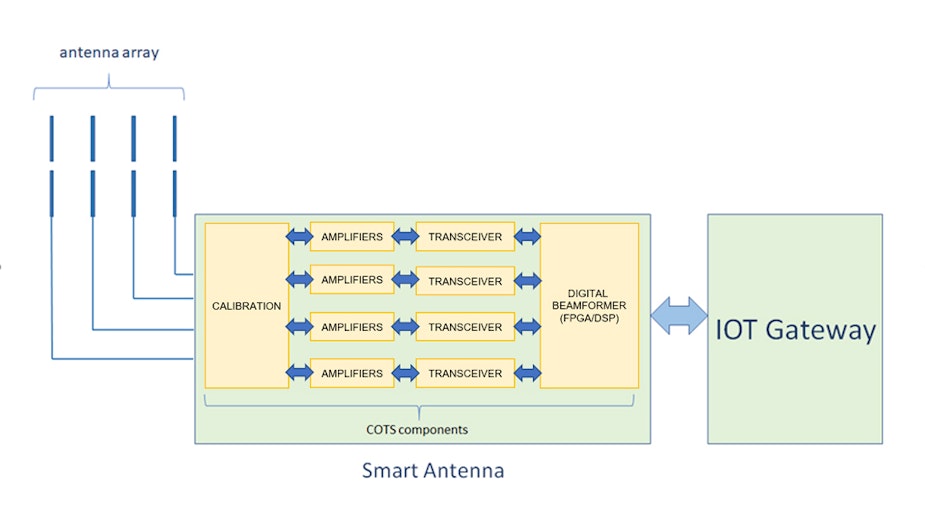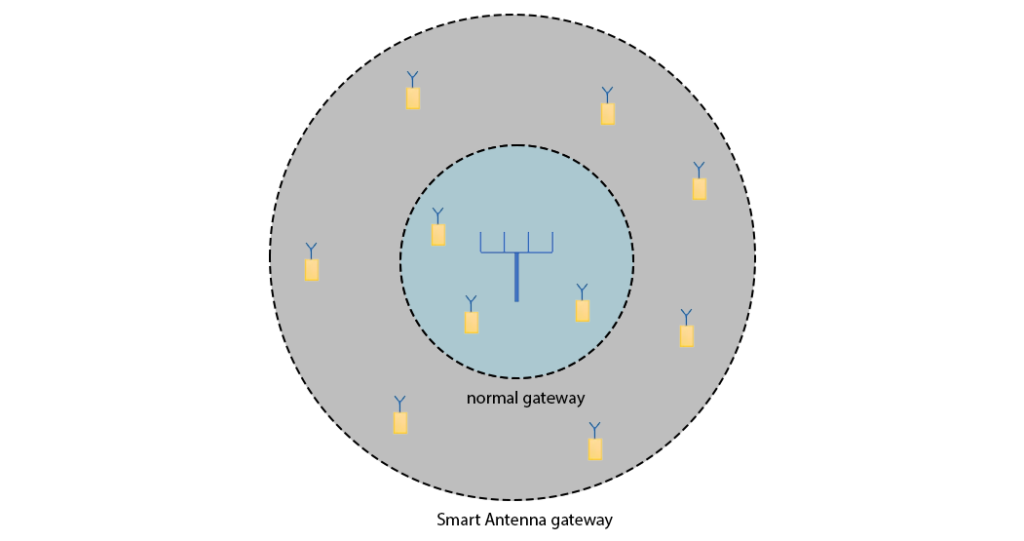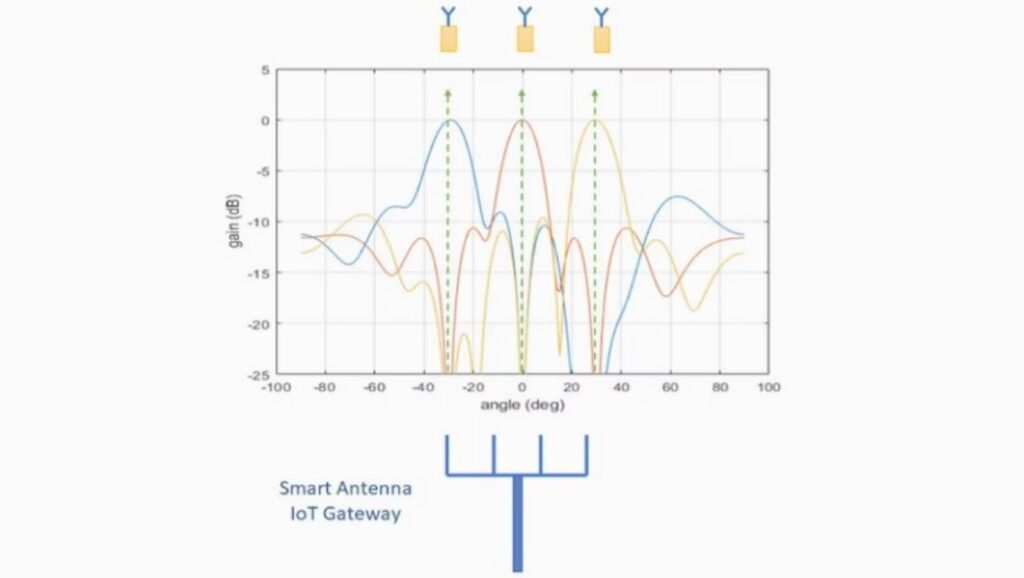Smart antennas for the IoT: for the few, not the many?
By Donal Price

Smart antennas can radically improve IoT network performance – and they can do this with no changes to the population of wireless IoT devices. Only the IoT gateway terminals – usually relatively few in number – need the upgrade. But ultimately everyone reaps benefits – network operators from improved coverage, data capacity, network resilience and location services, and network users from lower cost and lower power IoT devices.
Smart antennas are becoming increasingly common in other telecoms applications. In Wi-Fi and cellular networks, beamforming and MIMO techniques enhance capacity and increase user data rates. In the satellite industry, electronic beam steering eliminates motorised assemblies in high-end satellite terminals.
IoT networks, in contrast, typically still rely on antennas with fixed radiation characteristics, which fundamentally limits the operating distances and data rates of individual radio links and the capacity of the overall network.
Smart antennas can transform IoT deployments through advanced digital signal processing and antenna beamforming techniques. What’s more, these benefits can be realised without unacceptable capital expenditure and with no changes to IoT devices or radio protocols. Only the IoT gateway terminals need to be upgraded.
How do smart antennas work?
Smart antennas adapt their radiation characteristics to changing signal scenarios. They create wireless beams that are not only automatically steered in directions of interest but can also be shaped to reject interference and optimise the performance of each radio link.
When deployed at an IoT network gateway, a digital smart antenna can create independent beams to serve numerous IoT devices simultaneously and provide useful information on the signals that it receives — such as accurate information about the directions of the devices.
At the same time, smart antennas can improve the performance of remote IoT devices.
The radio transceiver within an IoT device is often the dominant consumer of energy. But the energy used by the transceiver is directly related to the performance of the antennas at both the device and the gateway. The ability of a smart antenna at the IoT gateway terminal to improve the radio links to all devices thus allows the transmission power – and hence energy consumption – of each IoT device to be reduced markedly. Not only can this increase the battery life of an IoT device, which typically operates from batteries or with harvested energy (e.g. from solar cells), but it can also reduce its cost through smaller batteries and less powerful radio transceivers.
Demonstrating the benefits of a Smart IoT gateway
The addition of a relatively simple smart antenna to an IoT gateway will yield significant benefits. For example, a 4-element array antenna (Figure 1) at a gateway can improve the radio link to the extent that the terminal’s transmission power can be reduced by a factor of up to 4. Such an antenna can be assembled at a modest cost using commercial, off-the-shelf (COTS) devices. In fact, TTP’s own smart antenna testbed was built using COTS radio transceivers and processors.

Improvements to radio links can also be used to extend the geographical area covered by an IoT gateway. In line of sight conditions, the increased antenna gain realised through a 4-element array allows the gateway to receive transmissions from twice the distance as a conventional antenna, instantaneously quadrupling the area covered by the gateway (Figure 2). This either allows the gateway to reach a greater number of users or makes it possible to serve a given population of IoT devices with less infrastructure, i.e. fewer gateways.

Figure 2: Increasing Coverage Area with a Smart Antenna
The maximum number of users that can be supported by any radio network is normally limited by the capacity constraints of the radio access technology and by interference between users. Advanced smart antenna techniques can overcome these limits.
Adaptive beamforming reduces interference by creating nulls in the antenna patterns in the directions of other users and unwanted signals (Figure 3). For systems with mobile devices, the direction of each beam and the positions of nulls adapt to the changing directions of all devices. This also protects against interference from neighbouring and overlapping networks as the density of IoT deployments grows.

The ability of smart antennas to reduce interference between users can be exploited to allow radio resources to be re-used amongst those users and consequently to increase the capacity beyond conventional limits.
For example, each beam steered towards a user terminal by our 4-element array antenna can reject interference from up to two other terminals, allowing all three terminals to operate using the same radio parameters (Figure 4). This is known as spatial division multiple access (SDMA). The principle can be applied across all devices, and this example shows that a modest smart antenna system can increase the capacity of an IoT system by a factor of up to three. Greater improvements are possible with larger arrays.

Figure 4: Spatial Multiplexing
Many IoT applications require position tracking of IoT devices in the field. One conventional approach is to equip IoT devices with a GPS receiver and for devices to report their positions. Drawbacks of this include the cost and energy consumption of the GPS subsystems, and the use of valuable radio bandwidth to report the positions of the IoT devices to the gateway. An alternative approach is to determine the positions of the devices at the IoT gateways, using the directions of arrival or the propagation delays of the devices’ transmissions. However, achieving high accuracy with these approaches over a large area can be challenging.
Smart antennas can improve position location techniques dramatically. Space-time processing algorithms improve ranging accuracy and mitigate the effects of reflections, whilst super-resolution direction finding greatly improves the accuracy of triangulation techniques.
An example of how smart antennas can be used to locate devices within an IoT network is illustrated by Figure 5. Here, multiple smart gateways are positioned at the edges of the coverage area, each producing a highly accurate estimate of device bearings. The gateways cooperate to triangulate these bearings, thus locating the IoT devices.
Illustrating the accuracy of this approach, simulations show that with a smart gateway placed at each corner of a 500 metre square grid, devices within the grid can be located to an accuracy of 1 metre. This far exceeds the accuracy of common ranging technologies (including that introduced by LoRa) and, moreover, can be retro-fitted to existing deployments, requiring no special features within the radio protocols or enhancements to the devices.

Figure 5: Locating IoT Terminals with High Resolution Triangulation
Smart antenna technology in IoT gateways can thus dramatically improve the performance of connected devices and of the IoT network as a whole, but without necessitating modifications to the population of wireless IoT devices. Wireless devices gain in battery life and operating range, whilst the IoT network benefits from increased capacity, improved tolerance to interference, and reduced infrastructure costs. Smart antennas can also add valuable features such as accurately locating and tracking the positions of individual devices.



